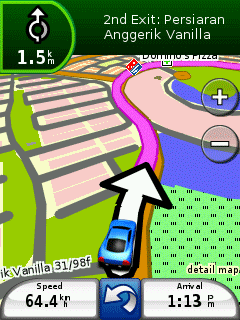The Star - Sunday January 4, 2009
On the double with Garmin
By HOMER ASHBURN
Two Nuvis at one go. Talk about having a full plate. We find out if the 205 and 710 measure up as a generic vernacular. To find out what the blazes we are talking about, skip to text.
AT FIRST glance, the likes of Frisbee, Kleenex, Panadol, Xerox, Velcro, Thermos and Jeep have as much in common as the 1812 Overture and an Ibiza rave.
After all, they are all different products.
Yet, they do. All those items are what are known as generic vernaculars. Simply put, when you ask for a headache pill, you ask for a Panadol, do you not?
We xerox notes and forms to each other, we fling frisbees, use velcro shoes and clothes, and drive around in jeeps.
In the local world of satellite navigation, GPS units are apparently generically called Garmins.
Ask for a sat-nav, GPS unit or in-car navigation system, chances are your installer of choice will simply tell you that you are looking for a Garmin, even if they are not selling you a Garmin.
 Showing the way: The Nuvi 205 (left) and Nuvi 710.
Showing the way: The Nuvi 205 (left) and Nuvi 710. Having never tested a Garmin before, it was with some surprise that two units arrived in the mail for review, the Garmin Nuvi 205 and its Nuvi 710 bigger brother.
Both are portable GPS units that can be mounted in the car as well as placed in your pocket, although the 4.3-inch 710 can seem a tad bulky when compared to its 3.5-inch little sibling.
First up to bat was the 205. Considered as an entry level unit in the European Union, the 205 proved to be a lovely little pocket rocket ... with some quirky idiosyncrasies, but more on that later.
Let’s just say that this baby Garmin is a nice introduction to the world of sat-nav, if you are not already a card-carrying member.
Forget the instruction manual. The 205 was so intuitive, it was probably no small wonder that its manual was probably the slimmest this writer has ever seen.
Using the 205 was easy, with the GUI providing you with just four options: help me find out where I want to go, show me where I want to go, how loud that nice female voice can monotonously tell me that I am going the wrong way and everything else in just one touchscreen button.
 The menu page of the 710.
The menu page of the 710. Actually, touch buttons one and four do offer more than just that but with the way the 205’s interface is designed, even the sometimes complex process of looking for an address or adjusting the 205’s internal system to suit your needs, becomes a tireless breeze. Simply lovely.
Setting up was also so, so easy. Plug in the power, stick the unit on the windscreen and, voila, instant GPS.
The strong feelings of joy were further accentuated by the fact that the 205 got its bearings in almost nothing flat ... unless you happen to be in an underground car park or riding Singapore’s MRT network.
So, does it work? For the most part, yes.
For slightly more than RM1,000, you get a nifty GPS unit that can be used in your car, in someone else’s car or on foot.
 The three-dimensional map view of the 710.
The three-dimensional map view of the 710. A test run in Kuala Lumpur – and its outskirts – showed the capabilities of the 205.
Only on two occasions, once when it was dark, rainy night and the other when it was a dark and rainy night deep amongst the high rises of our capital city, did the 205 slip up, taking more than 20 minutes to acquire satellite signals.
The acid test was a drive to Johor Baru and Singapore, two cities this reviewer has not been to since 1995.
And, while Singapore seemed the same yet not the same, the Johor Baru of 13 years ago was certainly not the Johor Baru of the 21st century. Did this bother the 205? Not one bit.
As long as you knew what you wanted, be it place name or street address or both, it got everything spot on from the get go.
The only thing that scuppered this little navigator was when it was surrounded by the high rises of Orchard Road or when it was travelling under the streets of the city state. Its small size also meant it fitted into pockets easily.
The 710 came a little later and, a technical glitch with the original unit, meant that the review time with the 205’s big brother was cut short prematurely.
In that short time, you could see why, in some cases, bigger is better.
For a start, the casing’s chassis looked sexier, more chic, more lifestyle than the 205’s standard dark gray.
The bigger screen was also easier on the eyes and, most importantly, the 710 came with a far larger disk space of navigating languages.
The 205 already had a formidable arsenal of guidance instructions in a variety of European and Asian languages, although it did sound like the same voice talent was recycled for several of the Asian languages.
The 710 had more to offer in that respect, even going so far as offering American, Australian English and English direction commands being spoken by Jack, Jill, Lee, Karen, Daniel and Emily, although Karen’s pronunciations in her thick Aussie accent were sometimes unintentionally funny, Pen-Cha-Lah-Link-Enk-Veh (Penchala Link NKVE) or Pah-Chang (Puchong) any one?
Visually, the 710 could also provide more details than the 205 could ever do.
 The 205 in night mode
The 205 in night mode And, perhaps because its larger size meant that a bigger processor could be fitted on-board, even at maximum settings, the 710 worked smoothly and effortlessly.
It even comes with Bluetooth connectivity, which meant that it could (and did) become a mobile phone hands-free kit.
So, are the Garmin units worthy of becoming a generic vernacular? Based on the performance of the 205 and the 710, you bet.
The Nuvi 205 is priced at RM1,199 and the bigger 710 at RM2,099.
The test units came courtesy of local Garmin distributor Automotive Synergy Inc Sdn Bhd. It can be contacted at tel: 03-7803 5633.
Click here for GME Garmin nuvi205W Package
Click here for GME Garmin nuvi760 Package

.jpg)



